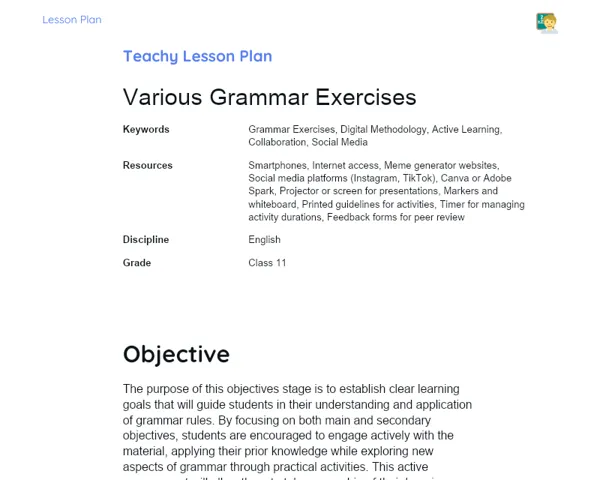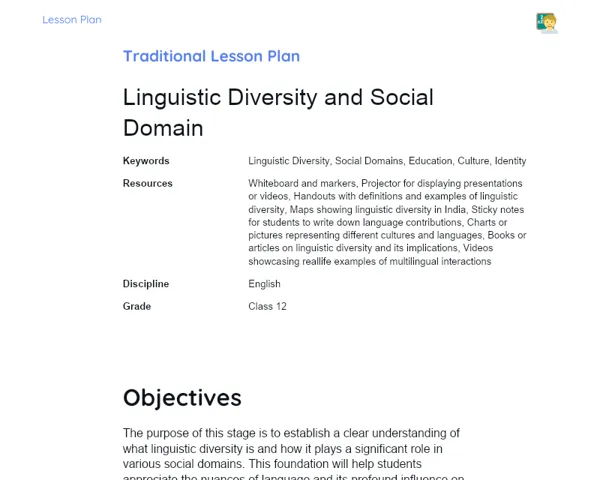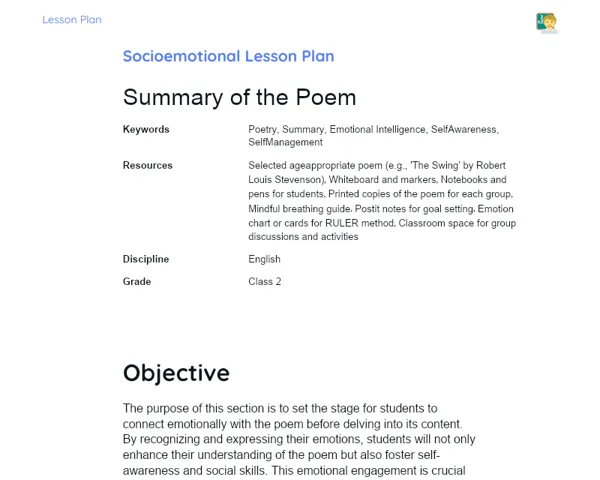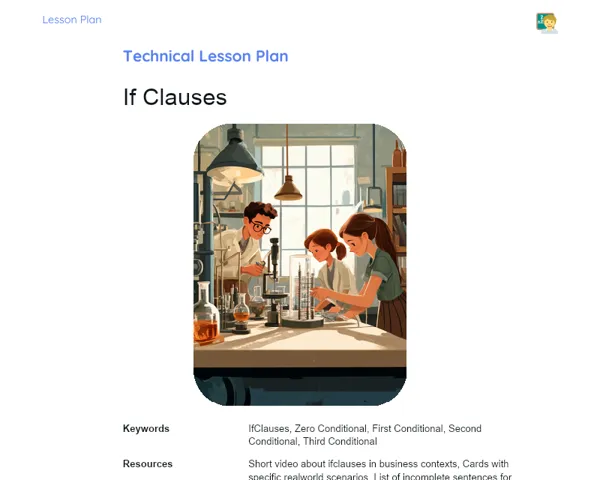Lesson Plan | Lesson Plan Iteratif Teachy | Verbs: Modal Verbs
| Keywords | Modal Verbs, Can, Could, May, Must, Should, Digital Methodology, Active Methodology, Social Media, Engagement, Contextualized Learning, Instagram Stories, Digital Influencers, Interactive Game, 360° Feedback, Group Discussion, Digital Communication, Creativity, Collaboration |
| Resources | Phones or tablets with internet access, Instagram accounts or fictitious accounts, Video editing apps (InShot, CapCut), Platforms for creating interactive games (Twine, Google Slides), Access to video sharing platforms (YouTube, TikTok), Paper and pen for notes and script writing, Projector or screen for showcasing works |
| Codes | - |
| Grade | 12th grade |
| Discipline | English |
Goal
Duration: 10 - 15 minutes
The goal of this lesson plan stage is to ensure every student is on the same page regarding what will be learned during the class, with a focus on key modal verbs. This will lay a strong foundation for upcoming practical activities, clarifying expectations and learning objectives.
Goal Utama:
1. Identify and understand the usage of modal verbs: can, could, may, must, and should.
2. Apply modal verbs in various contexts and everyday situations.
Introduction
Duration: 10 - 15 minutes
The aim of this stage is to energize students and activate their prior knowledge about modal verbs. This ensures readiness for practical activities and creates a collaborative learning atmosphere. Starting with quick research and discussion sets a real context for the use of modal verbs.
Warming Up
Modal verbs are invaluable in English, helping us express abilities, permissions, possibilities, and obligations. To kick off the warm-up, encourage students to use their phones to find an interesting fact or curiosity about any modal verb (can, could, may, must, should). This sharing will fuel an engaging discussion on the application of these verbs.
Initial Thoughts
1. What’s the difference in usage between 'can' and 'could'?
2. When do we prefer 'may' over 'can'?
3. In which contexts is 'must' appropriate?
4. How can 'should' be effectively used to give advice?
5. Can you provide examples of sentences using these modal verbs?
Development
Duration: 70 - 80 minutes
This stage of the lesson plan seeks to give students hands-on experience applying modal verbs in engaging, real-world contexts. By harnessing digital tools and creative activities, students can delve into the practical use of modal verbs in a meaningful and enjoyable manner. This solidifies their theoretical understanding while enhancing digital communication skills.
Activity Suggestions
Activity Recommendations
Activity 1 - Creating Instagram Stories with Modal Verbs 📸
> Duration: 60 - 70 minutes
- Goal: Apply modal verbs in practical and relatable contexts through a popular digital platform, fostering creativity and engagement.
- Deskripsi Activity: Students will craft a series of Instagram stories using modal verbs in various situations. They can use their own accounts or invent a fictitious one for the activity. The stories must depict everyday scenarios where modal verbs like 'can', 'could', 'may', 'must', and 'should' are utilized properly. Students should incorporate text, images, videos, and interactive polls to engage their audience.
- Instructions:
-
Divide students into small groups of up to 5.
-
Each group must select a theme for their stories, such as 'A day in the life of a student', 'Health tips', 'Planning a trip', or 'Study hacks'.
-
Before beginning, each group should list at least 10 sentences featuring various modal verbs for inclusion in their stories.
-
Using their phones, students will create the stories, integrating text, images, videos, and polls aligned with the theme and modal verbs.
-
Each group should publish their series of stories on an Instagram account and share the link with their peers and the teacher.
-
Finally, each group will present their stories, explaining the role of modal verbs in each segment.
Activity 2 - Digital Influencers and Life Tips 💡
> Duration: 60 - 70 minutes
- Goal: Foster creative application of modal verbs through digital content creation, allowing students to build communication and video editing skills.
- Deskripsi Activity: Students will envision themselves as digital influencers and create a short video (similar to a vlog) offering life tips using modal verbs. They can focus on topics like health, lifestyle, academics, or sports. The video should be edited and uploaded to a chosen platform, such as YouTube or TikTok.
- Instructions:
-
Organize students into groups of up to 5.
-
Each group should select an engaging theme for their tips.
-
Before recording, each group should draft a script that incorporates at least 10 sentences using modal verbs.
-
Utilize phones to film the video, allowing students to explore various scenarios and visual elements to enhance their tips.
-
Edit the video with accessible apps like InShot or CapCut.
-
Share the video on the chosen platform and send the link to the class and the teacher.
-
In the end, each group will present their video, emphasizing the use of modal verbs.
Activity 3 - Interactive Adventure Game with Modal Verbs 🎮
> Duration: 60 - 70 minutes
- Goal: Encourage the practical use of modal verbs in an interactive game format, promoting collaboration, logical storytelling, and critical thinking.
- Deskripsi Activity: Students will craft an interactive adventure story using a game creation platform like Twine or Google Slides. The narrative should include different scenarios and choices that necessitate the use of modal verbs to progress.
- Instructions:
-
Break students into groups of up to 5.
-
Each group will devise an adventure story with multiple scenarios and interactive choices.
-
The story must incorporate at least 10 scenarios where modal verbs guide decision-making (e.g., 'You can choose to follow the path through the forest, or you might try to climb the mountain.').
-
Employ Twine or Google Slides to build the narrative, infusing text, visuals, and interactive links for choices.
-
Present the completed game to the class and teacher, allowing peers to play and explore various choices.
-
Each group will then explain how modal verbs were embedded in their story.
Feedback
Duration: 20 - 25 minutes
This feedback segment aims to facilitate reflection and knowledge sharing among students, enabling them to learn from one another while consolidating their grasp of modal verbs. Moreover, the 360° feedback fosters communication, empathy, and teamwork skills, which are invaluable in both educational and professional settings.
Group Discussion
[Group Discussion] 💬
Lead a discussion where every group shares their learnings from the activities, guided by the following outline:
- Introduction: Each group should introduce their project (Instagram Stories, video, or interactive game).
- Learnings: Each group identifies their key takeaways about modal verbs.
- Challenges: Groups discuss any obstacles faced during the activities.
- Insights: Each student reflects on how the activity improved their understanding of modal verbs and ways to apply the knowledge in future scenarios.
Reflections
1. How was the use of modal verbs incorporated into your activity? Can you give specific examples? 2. What difficulties did you encounter while applying modal verbs digitally? 3. Post this experience, how can you use modal verbs in your daily life?
Feedback 360º
[360° Feedback] 🔄
Guide students to participate in a 360° feedback session where every student gathers feedback from peers in their group. Encourage students to provide constructive, respectful feedback, highlighting at least one positive element and one area for growth for each classmate. Use these guidelines:
- Be Specific: Focus on particular examples rather than generalizations.
- Be Constructive: Suggest practical ways for improvement.
- Be Respectful: Maintain a positive, respectful tone, appreciating each member's contributions.
Conclusion
Duration: 10 - 15 minutes
🎯 Purpose: 🎯 This conclusion stage invites reflection on the key learnings from the lesson, linking theoretical knowledge to practical applications in daily life. Summarizing and connecting modal verbs to modern contexts deepens students' understanding, making learning more impactful.
Summary
🎉 Alright everyone! Let’s quickly recap our lesson on modal verbs! 🎉
Verbal Superpowers: Just as a superhero utilizes their powers appropriately, modal verbs can, could, may, must, and should allow us to convey abilities, permissions, possibilities, and obligations. Think of them as fundamental linguistic tools that help navigate everyday English!
Practical Tips: We explored using 'can' for abilities (e.g., I can swim.), 'could' for past abilities or potential (e.g., I could swim when I was younger.), 'may' for formal permissions (e.g., May I come in?), 'must' for obligations (e.g., You must wear a seatbelt.), and 'should' for giving advice (e.g., You should eat healthy food.).
World
🌐 Connection to the Modern World: 🌐 In an age dominated by social media and digital communication, the ability to express oneself accurately in English is vital. Modal verbs enhance the clarity and effectiveness of our messages, whether in posts, videos, or blogs. Picture creating content that subtly guides, suggests, or obligates; this is where modals enrich communication, making it more appealing.
Applications
📱 Applications in Everyday Life: 📱 Mastering modal verbs is incredibly useful, not just in English classes but in daily interactions, such as asking for permission politely, proposing ideas to friends, or adhering to rules. They are essential for natural and effective communication in English, whether chatting with an international friend or during a virtual work meeting.



